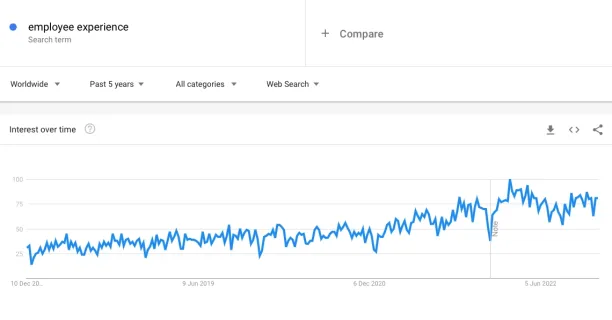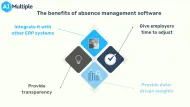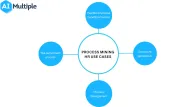Leave Management Automation: Top 4 Benefits in 2024
As workers leave their jobs at record levels, employee experience gained importance over the last few years (Figure 1). According to McKinsey’s research, two of the top reasons that affect employee experience negatively are:
- Not having caring leaders
- Having unsustainable work expectations

An efficient leave management process can alleviate the negative impacts of both factors as it gives employees the time they need to recharge, recover, or take care of their families and return to work refreshed and focused.
In this article, we’ll discuss what leave management automation is, the challenges of manual leave management, and the benefits of automation.
What is leave management automation?
Leave management automation, also called time-off management automation, is the practice of streamlining the leave management processes such as:
- Receiving time off requests
- Reviewing the leave balance of the employee
- Obtaining the approval of the manager of the employee
- Ensuring that the company’s leave policy is being followed
- Notifying the employee about their request
- Recording the leave for payroll calculation
This includes keeping track of:
- Vacation days
- Sick leave
- Maternity/paternity leave
- Public holidays
- Unpaid leave
Leave management automation aims to ensure that employees can take the time they need while also ensuring that the company’s operations are not disrupted.
What are the challenges of manual leave management?
Some challenges of manual leave management are:
Poor communication of leave policies
Miscommunication in the workplace can be costly: nearly half of business executives report delays or failures in completing projects due to communication barriers.1 Poor communication can also be a problem in leave management if employees do not have time to understand policies on:
- When they are entitled to take a leave
- The maximum length of time for a leave
- How often can they take a leave
- How their vacation days accumulate from one year to the next
Miscommunication about these policies can lead employees to take leave without proper authorization (absenteeism) or not be able to take the leave they are entitled to (presenteeism).
Payroll errors
Around 25%2 of employees state that they will look for a new job after experiencing a single paycheck error, and nearly half3 of Gen Z employees in the US say that they would never tolerate paycheck errors. Manual leave management with poor communication with payroll systems can result in overpayments or underpayments.
Poor tracking of leave requests
Managing leave requests manually can also lead to coordination problems as:
- When employees submit leave requests via form or email to their managers, the manager may lose track of this form, miss the email, or forget to enter the information into the HR system.
- There may be conflicting requests from different employees. Inefficient tracking of who is taking leave and when they leave can lead to problems in the project timeline and task allocation.
What are the benefits of leave management automation?
Improves the transparency of leave management
An automated leave management system can help improve the transparency of leave management by providing a central repository for all leave-related information, such as:
- Leave policies under specific circumstances
- Leave requests and their up-to-date status
- Who is out on leave and when they are scheduled to return
- Reports on leave usage trends
Automatically capturing and updating leave-related information can help businesses:
- Improve communication between HR departments, managers, and employees and ensure that everybody is on the same page
- Prevent misunderstandings and confusion about leave policies
- Efficiently allocate time and resources and prevent project delays due to absent employees
Reduces payroll errors
Automating the leave management process and linking your leave management system with your payroll system can reduce payroll errors. It can:
- Help ensure that leave days across the organization are recorded accurately and payroll is calculated accordingly.
- Keep track of when an employee takes leave and compare it against their approved leave days.
- Ensure that employees are correctly notified of their leave entitlements and prevent presenteeism.
You can also check our article on payroll automation for a more comprehensive account.
Improve employee experience
Automation can help improve the employee experience for both HR teams and employees across the organization:
- As discussed above, manually handling leave management tasks are daunting and time-consuming. Automation can reduce the administrative burden on the HR department and help them allocate time to more productive tasks that require human involvement.
- Automated leave management can also ensure that leave requests are processed promptly and efficiently to prevent delays that can cause employee dissatisfaction.
For more on HR automation
You can check our articles on:
If you have other questions about performance management and automation, we can help:
External Links
- 1.
- 2. “State of Payroll Study.” The Workforce Institute, 4 September 2019. Accessed 9 December 2022.
- 3. “What does Gen Z Expect at Work?” The Workforce Institute, 25 November 2019. Accessed 9 December 2022.

Cem has been the principal analyst at AIMultiple since 2017. AIMultiple informs hundreds of thousands of businesses (as per similarWeb) including 60% of Fortune 500 every month.
Cem's work has been cited by leading global publications including Business Insider, Forbes, Washington Post, global firms like Deloitte, HPE, NGOs like World Economic Forum and supranational organizations like European Commission. You can see more reputable companies and media that referenced AIMultiple.
Throughout his career, Cem served as a tech consultant, tech buyer and tech entrepreneur. He advised businesses on their enterprise software, automation, cloud, AI / ML and other technology related decisions at McKinsey & Company and Altman Solon for more than a decade. He also published a McKinsey report on digitalization.
He led technology strategy and procurement of a telco while reporting to the CEO. He has also led commercial growth of deep tech company Hypatos that reached a 7 digit annual recurring revenue and a 9 digit valuation from 0 within 2 years. Cem's work in Hypatos was covered by leading technology publications like TechCrunch and Business Insider.
Cem regularly speaks at international technology conferences. He graduated from Bogazici University as a computer engineer and holds an MBA from Columbia Business School.
To stay up-to-date on B2B tech & accelerate your enterprise:
Follow on

Comments
Your email address will not be published. All fields are required.